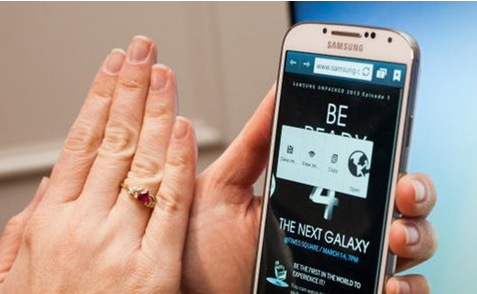Gesture That Smartphones Can Appreciate,Newscientist,May 17th,2013
智能手機能識別人類的手勢,新科學家科技雜志,2013年5月17日
Nowadays, there is a device that enables a smartphone's camera to recognise gestures without gobbling up precious battery life.
目前,有一種設備可以使智能手機的攝像頭識別人類的手勢,而且不會以減少電池的寶貴壽命為代價。
Microsoft's Kinect and the soon-to-be-released Leap Motion have thrust 3D gesture-recognition technology into the mainstream. Touchless phones,however,are still a rarity.
盡管非接觸式手機仍然非常罕見,微軟的Kinect和即將要發布的Leap Motion使3D手勢識別成為了一種主流技術。
Korean company Pantech released a smartphone in 2011 that could use it's camera to recognise simple gestures.
韓國泛泰公司在2011年推出的智能手機可以使用相機識別簡單的手勢。
But across the industry the capability has yet to catch on:
但在整個行業,這項技術還未盛行。

of the 1.6 billion mobile devices shipped in 2012, just 27 million (about 0.2 per cent) were equipped with gesture-sensing technology,according to ABI Research,a market research firm based in New York.
據總部位于紐約的ABI咨詢公司的調查顯示,在2012年,共有16億部手機的出貨量,而只有2700萬(約0.2%)部手機配備了手勢感應技術。
One reason may be that existing techniques infer gestures based on 2D images captured by a phone's camera.
原因之一可能是現有的技術可以基于手機攝像頭捕捉的2D圖像來判斷出手勢,
This is problematic because visually cluttered backgrounds can confuse the software.
但這存在一定的問題,因為視覺上雜亂的背景可以讓軟件產生混淆。
Kinect and Leap Motion illuminate an area with either an infrared laser or intense infrared light to capture depth information about a scene.
而Kinect1和Leap Motion2使用紅外線激光器或強烈的紅外線來照亮某一區域以捕捉這一場景的深度信息。
Now Andrea Colaco at the Massachusetts Institute of Technology Media Lab in Cambridge and colleagues have developed a system called 3dim.
目前,劍橋麻省理工學院媒體實驗室的安德里亞·柯拉科和他的同事開發了3dim系統(三維數字成像及造型),
3dim's software then looks for mathematical structures in the 2D image data in order to simplify the scene.
3dim軟件可以在2D圖像數據中查找數學結構以便簡化場景。
Tobias Hollerer at the University of California,Santa Barbara,sees more promise for 3dim as a Google Glass system because he thinks it's awkward to make gestures while you're holding a phone.
加利福尼亞大學圣巴巴拉分校的托比亞斯·霍樂爾認為3dim技術運用在谷歌眼鏡上會有更大的發展前景,因為他認為當人們拿著手機時不方便去做手勢。












